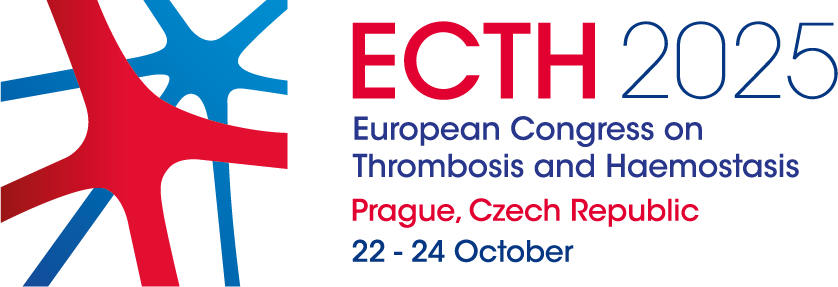Poster Session
Thursday 14 September

Abstract titles & Authors
17.00
18.30
Poster – Bleeding
P-001 – The axis NETosis-activated protein C may modulate the hemostatic status of patients with hemophilia A- Isabel Aleman-Cabrera, IISLAFE, Spain
P-002 – Two rheological modes in the injury site- Georgii Bykov, Russian Academy of Sciences, Russian Federation
P-003 – Introducing the F1+2 generation assay- Juergen Patzke, Siemens Healthcare Diagnostics Products, Germany
P-004 – Predictors of Health-Related Quality of Life in Adolescent Girls with Hereditary Bleeding Disorders- Mohamed Elshinawy, Alexandria University, Egypt
P-005 – Acquired von Willebrand Syndrome in the setting of unexpected major bleeding after invasive procedure: a delayed diagnosis- Maria Aguiar, Imuno Hemoterapy, Portugal
P-006 – Evaluation of FVIII PK Profile in Korean Hemophilia A Patients Assessed with myPKFiT: A Retrospective Chart Review- Eun Jin Choi, Daegu Catholic University Medical Center, Republic of Korea
P-007 – Comparative diagnostic study evaluating clot formation by rotational thromboelastometry in 63 patients with congenital dysfibrinogenemia- Tomas Simurda, Comenius University in Bratislava, Slovakia
P-008 – Validation of a freezing procedure for chromogenic factor VIII reagents- Hassan Al Khmis, Karolinska University Hospital, Sweden
P-009 – Hemophilia A use case scenarios for a portable testing device in different regions of the world- Anneke Sijbers, Enzyre BV, the Netherlands
P-010 – Rotational thrombelastometry in perioperative management of patients with inherited bleeding disorders- Kristina Maria Belakova, Comenius University in Bratislava, Slovakia
P-011 – WHEN THERE IS NO AGE LIMIT: AN ELDERLY PATIENT WITH MELAENA, SEVERE ANEMIA AND EXTREME HEMOLYSIS- Maria Mylona, National and Kapodistrian University of Athens, Greece
P-012 – The challenge of coagulation inhibitor therapy in dentistry – A community intervention project- Claudia Coelho, Unidade Local Saude do Nordeste, Portugal
P-013 – Cardiometabolic risk level of patient with hemophilia in Korea- Hong Hoe Koo, Korea Hemophilia Foundation, Republic of Korea
Poster – Clotting
P-014 – The plasma proteome and risk of venous thromboembolism (VTE)- Sigrid K. Brækkan, The Arctic University of Norway, Norway
P-015 – The association between venous thrombosis-associated genetic variants and coagulation factor levels and thrombin generation potential- Jihee Han, Leiden University Medical Center, the Netherlands
P-016 – Bladder cancer patients have increased NETosis and impaired DNaseI-mediated NET degradation that can be therapeutically restored in vitro- Raquel Herranz, The Health Research Institute Hospital La Fe, Spain
P-017 – Age and sex specific risks of major cardiovascular complications and death following elective hip and knee arthroplasty in the Netherlands: a Dutch Hospital Data Registry study- Mark Smeets, Leiden University Medical Center, the Netherlands
P-018 – Application of computer-based methods to discover and optimize bioactive compounds with anti-inflammatory and anti-atherosclerotic activities: from in silico to in vivo- Kanin Wichapong, Maastricht University, the Netherlands
P-019 – The increased NETosis in plasma of patients with periprosthetic joint infection is aggravated by lower DNaseI activity: potential therapeutic intervention to eliminate the bacterial biofilm- Raquel Herranz, The Health Research Institute Hospital La Fe, Spain
P-020 – Coagulation effects of inhibition of factor Xa by reversible inhibitors are different for the intrinsic and extrinsic activation pathways of factor X- Cornelis Kluft, Good Biomarker Sciences, the Netherlands
P-021 – Screening of tripeptide substrates specific to blood coagulation proteases- Elena Krivosheeva, Enzyre, the Netherlands
P-022 – Increased levels of NETosis-related cytokines in peritoneal fluid from advanced high-grade serous ovarian cancer patients- Julia Oto, The Health Research Institute Hospital La Fe, Spain
P-023 – Which score will predict the best the risk of first thrombotic event in cancer with a high risk of bleeding?- Teona Dumitru Dumitru, CHU Saint Etienne, France
P-024 – Alterations in thrombin generation after SARS-CoV-2 vaccination and the relation with inflammation- Willian Van Dijk, LUMC, the Netherlands
P-025 – Changes in the plasma proteome induced by a standardized autologous acute pulmonary embolism in a porcine model- Vårin Eiriksdatter Wikan, The Arctic University of Norway, Norway
P-026 – The onset of thrombosis in deep veins (DVT): the unexpected role of stretch and shear stresses on endothelial cells- Arianna Giannetti, Centre de Biologie Structurale, France
P-027 – Resting heart rate and risk of incident venous thromboembolism- Oda Leknessund, Trombosis Research Center, Norway
P-028 – Increased thrombin generation in patients with antibody-mediated rejection (ABMR) after kidney transplantation- Linda Lóczi, University of Debrecen, Hungary
P-029 – Urological cancer patients display an increase in markers of hypercoagulability and inflammation- Isabel Aleman-Cabrera, IISLAFE, Spain
P-030 – No detectable coagulation activation after vitamin K (MK-7) supplementation in patients on dialysis with functional vitamin K deficiency: a one-year randomized, placebo-controlled study- Else Marie Bladbjerg, University Hospital of Southern Denmark, Denmark
P-031 – Adipocyte fatty acid-binding protein and risk of future incident venous thromboembolism- John Bjarne Hansen, Norway
P-032 – Genome-wide genetic predictors of pulmonary embolism among those with a deep vein thrombosis- Nicholas L. Smith, University Of Washington, United States
P-033 – Elevated serum concentration of lipoprotein (a) is associated with hypofibrinolysis in patients with severe aortic stenosis- Magdalena Kopytek, Jagiellonian University Medical College, Poland
P-034 – Molecular characterization of antithrombin in samples of patients with deficiencies: a mass spectrometry-based next-generation test- Mirjam Kruijt, Leiden University Medical Center, the Netherlands
P-035 – Improved specificity of established activated partial thromboplastin time reagents for lupus anticoagulant detection- Martin Unterberger, Technoclone Herstellung von Diagnostika und Arzneimitteln, Austria
P-036 – Alterations of fibrinolysis in SARS-CoV-2 infected pregnant women: a prospective, case-control study- Rita Orbán-Kálmándi, University of Debrecen, Hungary
P-037 – Rotational thromboelastometry (ROTEM) measurements for the prediction of thrombolysis safety in acute ischemic stroke patients- István Szegedi, University of Debrecen, Hungary
P-038 – Circulating activated protein C levels are reduced in cancer patients, a novel contribution to tumorigenesis?- Maria Castaño, IISLAFE, Spain
P-039 – Staphylococcal biofilms: molecular scaffolds for the activation of blood coagulation- Vincenzo De Filippis, Università degli Studi di Padova, Italy
P-040 – EkoSonic Endovascular System promotes thrombolysis by altering fibrin fibre thickness and clot permeability- Cédric Duval, University of Leeds, United Kingdom
P-041 – The increase in plasma cell-free DNA in patients with venous thromboembolism is independent of DNase I activity- Raquel Herranz, The Health Research Institute Hospital La Fe, Spain
P-042 – Familial severe thrombophilia combined with inferior vena cava anomaly: Heterozygous Antithrombin Budapest 3 mutation- Nina Iversen, Oslo University Hospital, Norway
P-043 – Improved detection of lupus anticoagulants with new taipan snake venom time and ecarin time reagents insensitive to anticoagulation with vitamin K antagonists, direct FXa inhibitors, and heparins- Gary Moore, Technoclone Herstellung von Diagnostika und Arzneimitteln, Austria
P-044 – COVID-19: Clot Prevention in Hospital Inpatients- Clarissa Pui, Chelsea and Westminster Hospital NHS Foundation Trust, United Kingdom
P-045 – Evaluation of digital measuring device with an ADAMTS13 Activity Screening Test- Margaret Griffiths, Technoclone Herstellung von Diagnostika und Arzneimitteln, Austria
P-046 – An optimized thrombin generation reagent significantly increases sensitivity for detection of thrombogenic activity in immunoglobulin concentrates- Helga Vetr, Technoclone Herstellung von Diagnostika und Arzneimitteln, Austria
P-047 – Post COVID 19 catastrophic antiphospholipid syndrome (CAPS): case report in pediatrics- Armando Estrada, HOSPITAL BENJAMIN BLOOM, El Salvador
P-048 – Bilateral renal artery paradoxical embolism in a patient with concurrently revealed unknown patent foramen ovale and antiphospholipid syndrome- Maria Mylona, National and Kapodistrian University of Athens, Greece
P-049 – Intracardiac thrombus, a rarely cardiac manifestation of antithrombin deficiency.
Is screening for congenital thrombophilia useful?- Bounab Lyamine, Regional Military University Hospital of Blida, Algeria
P-050 – Single-center real-world experience with Idarucizumab for Dabigatran reversal- Ana Mendoza, Hospital Universitario La Paz, Spain
P-051 – The usefulness of capillary blood collection devices for coagulation parameters detection in hemophilia- Lisa Van Engelshoven, Enzyre, the Netherlands
P-052 – How can we best inform patients of the risk for hospital acquired VTE? A comparison of patient information leaflets and results from a patient survey- Aidan Haslam, University Hospitals Birmingham, Afghanistan
P-053 – Refining the diagnosis of antithrombin deficiency with next-generation protein diagnostics and molecular defined (glyco)proteoforms- Michelle P. van der Helm, Leiden University Medical Center, the Netherlands
P-054 – SEM AND 3D RECONSTRUCTION OF EX-VIVO ARTERIAL THROMBI: A PILOT STUDY- Barbara Baráth, University of Geneva, Switzerland
P-055 – Lupus Anticoagulant: Does a normal confirmatory test value necessarily mean time correction?- Eleni Vagdatli, Hippokration Hospital of Thessaloniki, Greece
P-056 – How to manage anticoagulant therapy of a patient with Antiphospholipid Syndrome with thrombosis and Systemic Lupus Erythematosus with hemorrhage- Teresa Mota, Centro Hospitalar Universitário de São João, Portugal
P-057 – The first administration of caplacizumab in the first line of treatment for acquired acute thrombotic thrombocytopenic purpura in Slovakia- Renata Pizurova, National centre hemostasis and thrombosis, Slovakia
P-058 – Association of the FVIII/DD and FvW/DD indices as an indicator of severity and mortality in patients with COVID-19- Brenda Sarai Zuñiga Ascencio, Instituto Nacional de Enfermedades Respiratorias, Mexico
P-059 – Analysis of a cohort of patients with COVID-19 and risk factors for the development of coagulopathy associated with SARS-CoV2 through scales proposed by the ISTH in the Mexican population- Brenda Sarai Zuñiga Ascencio, Instituto Nacional de Enfermedades Respiratorias, Mexico
P-060 – Overexpression of FXII as a risk of thrombosis in patients with SAMTER syndrome, angioneurotic edema, and its association with smoking rate and hematological parameters- Brenda Sarai Zuñiga Ascencio, Instituto Nacional de Enfermedades Respiratorias, Mexico
P-061 – Protein S deficiency is associated with an Increased Risk of DVT in Pregnant Women Using Oral Contraceptive- Abdulrahman Algarni, northern border univesrity, Saudi Arabia
P-062 – Heterozygous FV Leiden mutation associated with multiple cerebral venous thrombosis in childhood. A case report- Yacine Larfi, Central Hospital of Army, Algeria
P-063 – Exploring transcriptome diversity of human liver using nanopore sequencing- Pedro Garrido Rodríguez, CIBERER, Spain
P-064 – Platelet count as a non-invasive biomarker for portal hypertension complications in patients with liver cirrhosis- Mohamed El Horri, Regional Military University Hospital of Oran, Algeria
Poster – Platelets
P-065 – Platelet F11R/JAM-A contributes to platelet adhesion under flow conditions and to thrombus formation- Tomasz Przygodzki, Medical University of Lodz, Poland
P-067 – Spontaneous platelet aggregation assessed by light transmittance aggregometry: an attempt to establish laboratory reference intervals- Nikolaos Androulakis, University Hospital of Heraklion, Greece
P-068 – EXPERIENCE OF USING AVATROMBOPAG IN A TERTIARY HOSPITAL- Raquel Iglesias, Hospital Alvaro Cunqueiro, Spain
P-069 – The Mean Platelet Volume values in new inflammatory indices in COVID-19 patients- Athanasia Agorasti, General Hospital of Xanthi, Greece
P-070 – Glanzmann Thrombasthenia and total thyroidectomy: a hemostatic challenge- Rita Queirós Pereira, Centro Hospitalar Universitário de São João, Portugal
P-071 – The Mechanisms of platelet activation in Inflammation- Shaghayegh Rashvand, University of Westminster, United Kingdom
P-072 – Distinguishing pathological from physiological activation of platelets potentiated by exercise- Aleksandar Dishkelov, University of Westminster, United Kingdom
P-073 – Dealing with Glanzmann Thrombasthenia- Liliana Fonseca, Centro Hospitalar Tondela-Viseu, Portugal
